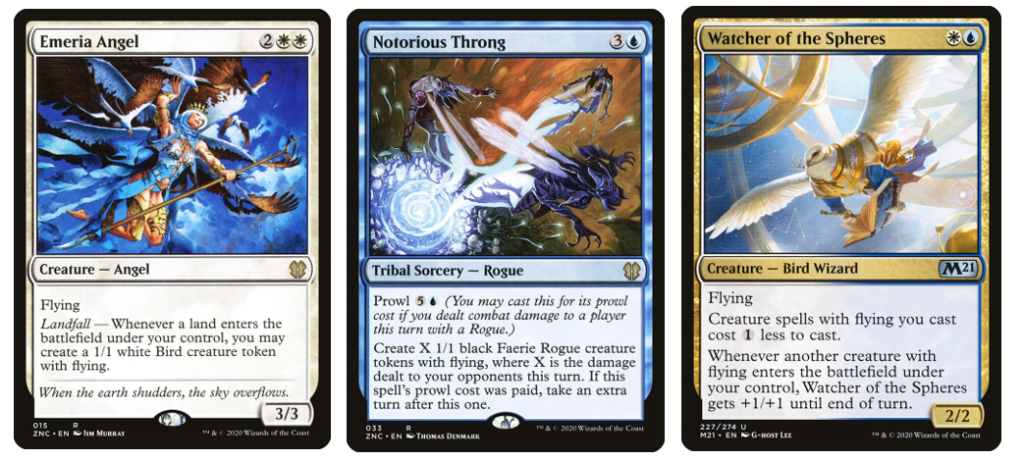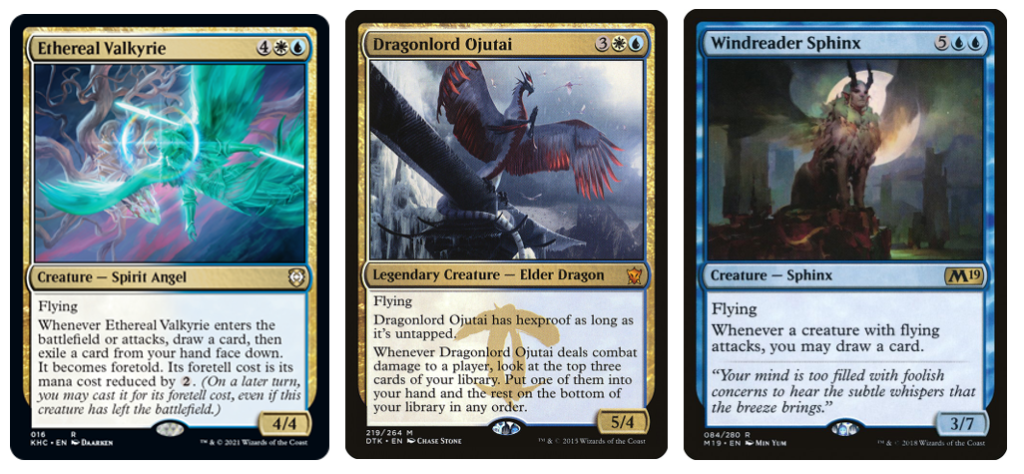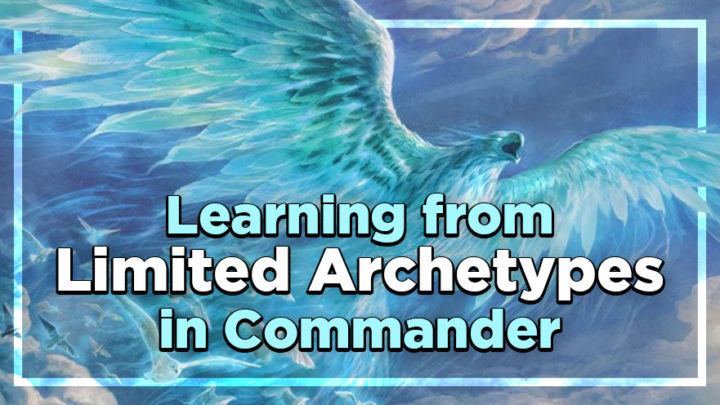We all have a favorite Limited archetype, and whether that’s Blue-Red Spellslinger, Five-Color Green, or Blue-White Flyers, there’s something satisfying about the gameplay that keeps us coming back for more. Today, I want to look at how to capture one of those archetypes in an EDH deck. We’ll look at how to “scale up” that archetype for Commander, what cards work, and how to ensure you have ways to end the game.
UW Flyers: A Classic Archetype
Blue-White Flyers — or “UW Skies,” as it’s sometimes known — is an archetype built around aerial dominance backed up by strong interaction. The deck seeks to chip away at the opponent’s life total turn after turn with evasive creatures while either gumming up the ground with blockers or trying to win the race.
These decks achieve this balance with a mix of strong interaction — like counterspells or pump spells — or by choosing creatures with strong tempo-changing abilities. Roaming Ghostlight is a perfect example — it bounces an opposing creature, and can also get in for a decent amount of damage after the fact.

Spectral Sailor, meanwhile, allows you to keep drawing cards past the point it can get in reliably for damage, while Empyrean Eagle seeks to power up the rest of the flyers you have in play. The UW Flyers deck wants as many of these complementary cards as possible as it seeks to evade the other player and sustain the assault.
Unfortunately, it’s not as simple as that when it comes to Commander. In Commander, board wipes happen. Your opponents might have large creatures that can block. And did I mention the life totals are a lot higher? Just like burn decks, this archetype doesn’t translate to EDH quite so plainly. Let’s look at how to make it work.
Linvala, Shield of Sea Gate

Linvala, Shield of Sea Gate is the perfect starting point. While many dismissed her early on as a Commander that didn’t give enough value for getting a party together, I think y’all are missing a trick. The detain ability is flavor text most of the time, as what makes her really tick is the ability to sacrifice her to keep your board in play.
Having an instant-speed sacrifice outlet in the Command Zone that can either grant your creatures hexproof or indestructible is huge.

Some of the best Limited — and, indeed, Constructed — playables of all time have been evasive creatures that can otherwise protect your other creatures. Most of the Modern Bant Spirits deck is not just playable in Pioneer, but winning tournaments, and it exists because of just how strong the archetype is. Evasive flyers with strong interaction is a deadly combo, and it’s an ethos I’ve ported over to my Aurelia, the Warleader Boros deck.
Linvala, then, offers a great starting point. But how do we patch up the weaknesses?
Lean into Control

First up, we need to lean into control — we’re playing Azorius, so why wouldn’t we? Control isn’t always reactive, and so playing some of the better flying hatebears is advisable.

We want to slow the game down, but not grind it to a halt. Instead of Archon of Emeria — which actually harms us, stopping us holding up interaction — we’re opting to run a deck mostly devoid of enters-the-battlefield effects. We can stop our opponents from using theirs with some of our hatebears, while Linvala can shut off abilities. Fog Bank helps us buy time while we’re setting up, and Nimble Obstructionist is a flexible way to interact.

Of course, we also have plenty of interaction, too. From counterspells to removal, we have plenty of ways to ensure the puzzle of a board state we build takes a little more to unpick than you’d think.

There’s also some room for more niche interaction. As we’re playing Unwind — a counterspell that’s essentially free — we have the ability to hold up other spells, too. I really like Fumble in a deck with all flyers, as it’s a surefire way to get damage through against Voltron decks. Brought Back obviously brings Linvala back to play, while Vanish into Memory is a way for us to dig deep for answers, knowing that whatever creature comes back is unlikely to trigger an ETB — and unlikely to avoid harm completely — all while refilling our hand.
Building a Board

I mentioned building up a board state as setting a “puzzle,” and I meant it. We’re here to keep our board, and so when Selfless Spirit and Linvala herself aren’t enough, we have ways to further obfuscate our creatures. Sephara, Sky’s Blade is really easy to power out for one white mana in this deck, which is always nice. Making them nigh-on untargetable is the goal, and you’d be surprised how resilient you can make your army.

And that army fills out quick enough. Notorious Throng won’t always let us take an extra turn given we only play three rogues, but it will give us an army in a can. Combined with landfall triggers from Emeria Angel, cost reduction from Warden of Evos Isle and Watcher of the Spheres, and healthy buffs from Kangee, Sky Warden and Kangee’s Lieutenant? Life totals will drop.
Curving Out into a Finisher
A classic UW Flyers deck often curves out into a chunkier flyer to end things. Whether that’s a mere Air Elemental or something more substantial like a Cavalier of Gales, it matters little — you just want something hard to block.

Dream Trawler is the classic example of a Limited finisher, and in many ways, it’s kinda busted. We’re happy to port this card over to EDH, as it can do a lot of work here, too. It’s not a game-warping card by any means in multiplayer, but it augments Linvala’s protection with its own, has lifelink, and draws us cards.

The other finishers in the deck — Sephara aside — all lean into helping us draw into our game-winning interaction, while being beefy bodies themselves. This deck can draw a lot of cards when it wants to, and it always feels good resolving these creatures.
Scaling Up Interaction
Some of our most powerful and most useful cards are the pieces of interaction we run. There’s a bit of a difference between cards that cut it in 1v1 Magic and Commander, though, so we need to understand how to scale these cards up to suit multiplayer.

In Limited, there are usually just one or two awkward blockers standing between you and victory. In those instances, a protection spell like Gods Willing or a bounce spell like Unsummon is often more than enough to close a game. If you need a little extra, you of course have access to the uncommon blue cards like Floodwaters, or the white anthems like Inspired Charge.
Sadly, these don’t quite cut it in Commander. Instead, you want two things from your interaction: modality and power. Now, it’s obvious which are the most powerful spells in Magic, and if you’re familiar with them, you’ll notice that Teferi’s Protection is missing from my list when you see it shortly (I just ran out and wanted to play something different!).
Modality, on the other hand, is less straightforward. Sure, some cards have modality, quite literally, but some cards are modal in their application, which is a little less obvious.

Akroma’s Will is one such flexible card in our deck. We can use it both reactively as a way to save our board, or proactively as a way to swing with impunity to try and progress the game. Cryptic Command works for us in much the same way; yes, it can counter a spell, or draw us a card, but it can also be used proactively to bounce a problem creature or enchantment, or even tap down an opposing board of creatures entirely.

Other cards are a little more niche, but still very modal. Spear of Heliod both buffs our creatures and gives us a way to stop the crackback when we don’t have vigilance. Meanwhile, Open into Wonder and Polymorphist’s Jest do more than just draw us cards or fog an attack — we can also use them aggressively.
I love having this much flexibility with my interaction, and though the gameplay can feel similar to playing the UW Flyers archetype in Limited, having such modality helps to scale it up to a multiplayer game where you can’t always predict what will happen.

Of course, Faerie Formation is the real star of the deck. It lets you hold up all of this magnificent interaction without losing tempo if you don’t need to play it. I’ve also ported this line of thinking into two of the better adventure creatures from Throne of Eldraine. Modality is king, and it lets us play more than 100 cards.
The Secret Sauce
Inevitably, a time will come when you’ll have used Linvala to protect your board, and you’ll have no more interaction left to protect your team. It’s going to happen, and it’s not going to be fun.

That’s where the two most fun cards in the deck come in. With Gift of Immortality and Nim Deathmantle, you’ll be able to have Linvala back in play each time she sacrifices herself to save the team. What’s more, with the way the triggers will be placed on the stack, she’ll be back in play before her trigger to give your creatures indestructible or hexproof resolves, which is just fantastic. It allows you to survive a board wipe, and more importantly? You can be proactive and wrath while keeping your own board. Lovely.
I of course can’t cover these sweet pieces of tech without giving a shout out to Lenny Wooley, who pointed out to me how good Gift of Immortality is while I was brewing. My mind immediately jumped to Nim Deathmantle, and we’ve enjoyed comparing notes since. I caught up with him recently to get the lowdown on what attracted him to building this archetype, and why he chose Linvala:
“As for what drew me to Linvala, it was the ability to protect high value creatures from removal. I saw her as an effective way to combat the weakness of aggro to board wipes.”
We chatted some more, and agreed that being able to truly port over aggro to Commander was exciting, and that a lot of the newer cards seem to be trying to solve that issue. In my playtesting of the deck so far, I’ve found it highly resilient and a lot of fun. I’d built Geist of Saint Traft Spirits in the past, but it always felt a little hamstrung by sticking solely to spirits, and a little too Voltron otherwise.
It’s also worth saying that Linvala brings a fresh new approach to playing Azorius in Commander, a color pair that might now be in more need of new playstyles than Boros — though I’m sure you might still disagree!

You can find the final decklist here. I’ve avoided some of the more overplayed staples like Smothering Tithe and Teferi’s Protection, and of course a great many value-based ETB creatures like Sun Titan and Mulldrifter, purely because we’re playing a Torpor Orb-based build. There’s definitely an argument for including an actual Torpor Orb, and I have a few cards like Inniaz, the Gale Force and Counterspell on the to-test list, too, but it’s overall in great shape and I can’t wait to play with it more.
I hope you enjoyed today’s article, and that some of the cards mentioned and the ways to scale up from 1v1 Magic to multiplayer were useful. UW Flyers always feels great to play, and with any luck, today’s list has given you some inspiration.
What Limited archetype shall I tackle next? Let me know on Twitter.

Kristen is Card Kingdom’s Head Writer and a member of the Commander Format Panel. Formerly a competitive Pokémon TCG grinder, she has been playing Magic since Shadows Over Innistrad, which in her opinion, was a great set to start with. When she’s not taking names with Equipment and Aggro strategies in Commander, she loves to play any form of Limited.

